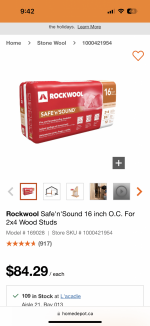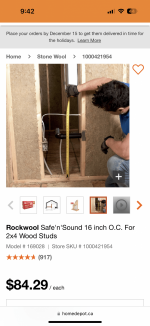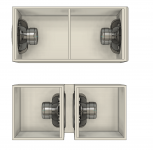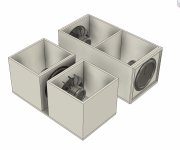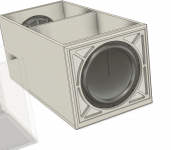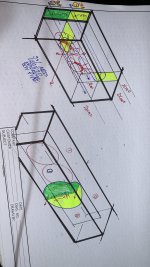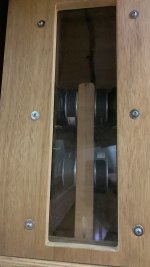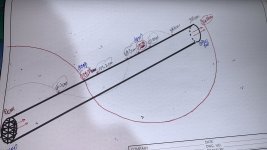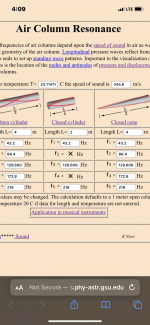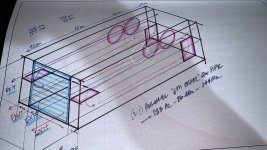What stuff, sorry?This stuff is sooooo intersting!!
Care to explain that’s interesting? I’m not used to look at graph.
I can see the option for 4th and 6th order bandpass in winisd, but can’t select them.The simulation results from both programs usually match with the simple constructions, like closed and vented. If things get more complicated, like horn, transmission line and bandpass, you will end up with hornresp. Maybe the best free program today.
Probably because I don’t have the pro version.
That’s the stuff we’re calling rock wool here:Sorry, the "Rock Wool" you mention seems to be another quality than that what I and the loudspeaker industry use.
Inside the sub woofer the speed of sound is slowed down in this loosely packed material, which results in a measurable lower resonance frequency of the closed box. Damping is a side effect in this use.
You do not stuff it inside with force, but fill it very gently compressed. This has been done for ages and the effect is not a matter of discussion.
"Glass wool", even as mentioned quite often, is not suited for this task and confused with "Rock wool", which stands for a mineral wool made from basalt or dolomite.
If you want to damp out resonances in vented cabinets, you will not use rock wool, as it may disperse it's fibers into the room. Even as these are non toxic, we are concerned about any foreign matter in our living space.
Here the usual material of choice is acrylic wool, as you will find it in a pillow. Indeed there is a cheap IKEA pillow, which is very often used for this task. Of course any cheap material designated to DIYS suddenly gets extremely expensive... so IKEA saves you quite some money filling your speaker.
There are many other products of this kind, promoted to improve the sound of speakers. In most cases very cheap if used in buildings, renovating, insolating,and huge amounts. Then offered as special quality, from a "speaker shop", costing ten or twenty fold. Don't get fooled, there is hardly any product made soley for speakers, just matching industry products rebaged.
Like bitumen, which is dead cheap as roofing felt.
As a general rule, gluing or nailing something to the inside of a speaker cabinet may be useful, while in a sub woofer it is wasted time and money. Such viscous elastic stuff like bitumen work well for higher frequency, but do not effect low ones.
You may have noticed the effect when you hear the bass even outside a concert venue, but any higher frequency is blocked from walls and windows.
Attachments
Not sure what is 2 side board with open shelf in the middle?!The mentiones Ultimax drivers are more on the side of equalized, closed cabinets, that is right. On the other side, when the much larger volume is acceptable, vented they work just as well and gives about 4dB higher output in the low end. Theorie expects +6dB but no mechanical system works without losses. Anyway this is very respecable and the higher output doesn't need more amplifier power. The worse impulse behavior and group delay are more a case for academic discussion than practical relevance. When the listening room is finished with bending the sub's output, there usually is not much left of these advantages.
This is for a sub woofer! Smaller drivers may in fact profit from the closed construction concerning these parameters.
Two drivers on opposing sides of a cabinet are much better than a single driver. Sure!
If one can afford the cost and space, this should be considered. The moving mass of the cones, which can even moves large sub woofer on the floor at high levels, is completely canceled out. The cabinet is resonating much less. This has a hear able effect.
Having the cones left an right may even be an design advantage, if WAF is a factor. Think of a side board with an open shelf in the middle.
Down firing would have been best for WAF here. But having a slot or even at both end of the table doesn’t seem to offend her.
Wanted to naked a post with this, but I did this quickly this morning:
Would need to see if this slot type is appropriate for my use case.
Attachments
You're welcome! Please make it sooner than later if interested in pursuing DIY audio at least as a hobby; you'll thank me later. 😉Oh gotcha! Thanks you. Will definitely have a look at horn resp one day.
Will do! For sure! Will download it this week!You're welcome! Please make it sooner than later if interested in pursuing DIY audio at least as a hobby; you'll thank me later. 😉
I find that this hobby suit my interest very well.
I’m just not very knowledgeable yet. And it’s pretty abstract for me all that.
No clue, just know others have posted sims using them in what appears to be the same version as you're using.I can see the option for 4th and 6th order bandpass in winisd, but can’t select them.
Probably because I don’t have the pro version.
Regardless, did what I call a ''classic' max flat BP4 and while the UM 18-22 sims an impressive THX LFE's ~20-120 Hz BW, it's single driver Xmax limited peak SPL barely meets the THX 115 dB/mains peaks, so need two to reach THX LFE 120 dB peaks which requires a 360.7 cm^2 x 147 cm long vent, so ~160.223 L net + drivers, construction materials.
In short, either need to reduce performance expectations and/or find drivers better suited to your app and/or change the app's design.
Attachments
Cool! 😎 👍 The more the merrier! 🙂I find that this hobby suit my interest very well.
I’m just not very knowledgeable yet. And it’s pretty abstract for me all that.
Understood, I had the original for at least a decade? before actually trying to use it as it seemed so 'alien' to my basically (intentionally) clueless knowledge of all things computer beyond using some simple drafting or 'fill in the blank' programs that others designed/made for me (mostly long gone Lotus? 1,2,3? and MS WORD, Excel on some damaged HDs)
Is this sim txt file the slot port shown (as a single)? (I’m always looking to try new things)No clue, just know others have posted sims using them in what appears to be the same version as you're using.
Regardless, did what I call a ''classic' max flat BP4 and while the UM 18-22 sims an impressive THX LFE's ~20-120 Hz BW, it's single driver Xmax limited peak SPL barely meets the THX 115 dB/mains peaks, so need two to reach THX LFE 120 dB peaks which requires a 360.7 cm^2 x 147 cm long vent, so ~160.223 L net + drivers, construction materials.
In short, either need to reduce performance expectations and/or find drivers better suited to your app and/or change the app's design.
Attachments
Not sure what I have to look for I. The text file.No clue, just know others have posted sims using them in what appears to be the same version as you're using.
Regardless, did what I call a ''classic' max flat BP4 and while the UM 18-22 sims an impressive THX LFE's ~20-120 Hz BW, it's single driver Xmax limited peak SPL barely meets the THX 115 dB/mains peaks, so need two to reach THX LFE 120 dB peaks which requires a 360.7 cm^2 x 147 cm long vent, so ~160.223 L net + drivers, construction materials.
In short, either need to reduce performance expectations and/or find drivers better suited to your app and/or change the app's design.
What’s BP4 ? 4th order bandpass?
What’s BW in “~20-120hz BW”
So need 2x um18 to get to THX lfe db. Which each of the um18 would need a 160l box with a 147cm port with a 360 cm^2 area?!
I don’t understand the last part about lowering expectations. And or find other driver for my application.
Is this sim txt file the slot port shown (as a single)? (I’m always looking to try new things)
I thought you used HR........anyway, no it's simmed as a vented chamber, though assume it could be merged into just a long high aspect duct........ not sure if HR has sealed SLOB open type loading simming capability.
To each their skills I guess. I’m 35. I’ve grown up using computer. My father worked in informatif all his life. He was the one to repair my computer when it broke. But I’m pretty fast to learn new software, usually.Cool! 😎 👍 The more the merrier! 🙂
Understood, I had the original for at least a decade? before actually trying to use it as it seemed so 'alien' to my basically (intentionally) clueless knowledge of all things computer beyond using some simple drafting or 'fill in the blank' programs that others designed/made for me (mostly long gone Lotus? 1,2,3? and MS WORD, Excel on some damaged HDs)
But audio stuff is so full of technical term and very specific stuff, that’s what I find hard.
Yeah, audio isn't hard or I wouldn't know it, but it does have its own language. I had the option to get in on computers in '64 with a Burroughs' JIT 'scholarship' (job in training), but punching cards and learning new programming codes seemingly every month just wasn't my 'thing', though fast forward to my daughter that was raised learning it along side the regular curriculum it was just another math/word puzzle to her, so became quite the programmer, etc., among other sciences, what with my dad's higher math skills that 'jumped'/'skipped' right over me. 🙁
For starters, learning basic T/S theory inside-out is a good start.
For starters, learning basic T/S theory inside-out is a good start.
I will start by looking at this stuff for sure! kinda jiberish for me right now. I get that those spec have an incidence on how the driver behave, but I dont know each spec and what they mean!Yeah, audio isn't hard or I wouldn't know it, but it does have its own language. I had the option to get in on computers in '64 with a Burroughs' JIT 'scholarship' (job in training), but punching cards and learning new programming codes seemingly every month just wasn't my 'thing', though fast forward to my daughter that was raised learning it along side the regular curriculum it was just another math/word puzzle to her, so became quite the programmer, etc., among other sciences, what with my dad's higher math skills that 'jumped'/'skipped' right over me. 🙁
For starters, learning basic T/S theory inside-out is a good start.
always happy to learn!
My mind fawk currently:
When is a sealed box ‘better‘ than a qw pipe box that only has one exit, as it has been folded up and designed around the three to one ratio of that (second) odd harmonic? A qw bp6 parallel 3:1, for example
as far as using it In the ‘room’ Full of ‘modes’ ?
When is a sealed box ‘better‘ than a qw pipe box that only has one exit, as it has been folded up and designed around the three to one ratio of that (second) odd harmonic? A qw bp6 parallel 3:1, for example
as far as using it In the ‘room’ Full of ‘modes’ ?
Might want to elaborate on the 'F' word usage.......... 😉
Regardless, from an acoustical POV, basic sealed is best for overall damping a driver Vs the TQWT to primarily damp its impedance peak.
Regardless, from an acoustical POV, basic sealed is best for overall damping a driver Vs the TQWT to primarily damp its impedance peak.
For newbie like me, what a qw bp6 parallel 3:1 ?!My mind fawk currently:
When is a sealed box ‘better‘ than a qw pipe box that only has one exit, as it has been folded up and designed around the three to one ratio of that (second) odd harmonic? A qw bp6 parallel 3:1, for example
as far as using it In the ‘room’ Full of ‘modes’ ?
I guess it’s a quarter wave 6th order bandpass. But why would it be good versus sealed.
I do like special « design » like this (when I google to see picture).
3:1 length and a split of cross sectional area at the ‘middle’ based on the harmonic interval in closed end pipes .
these all sim ‘perfect’ in HR generically. And have offsets driver entry points that maintain the ‘perfect’ as well
these all sim ‘perfect’ in HR generically. And have offsets driver entry points that maintain the ‘perfect’ as well
Attachments
Last edited:
Still a bit confused honestly! Haha!Longer and expanded csa or shorter and reduction csa (mass loaded)
- Home
- Loudspeakers
- Subwoofers
- Need help designing a home theater subwoofer
